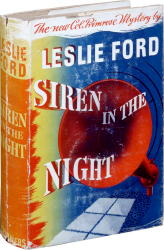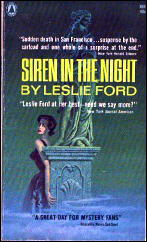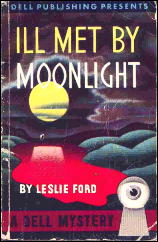by Marcia Muller

LESLIE FORD – Siren in the Night. Charles Scribner’s Sons, hardcover, 1943. Paperback reprints include: Bantam #303, 1948; Popular Library K68, 1964.
Grace Latham, Colonel Primrose, and Sergeant Buck reappear in yet another locale in this wartime story. Grace is spending the spring in San Francisco because her son, a naval air cadet, is stationed there; Primrose and Buck have traveled west because of the colonel’s involvement in the war effort.
The city is at its charming best, except for placards indicating where the air-raid shelters are and “the sudden rising wail of the alert siren, and the lights of that Golden City fading like a million synchronized fireflies dying in the night.”
A blackout, in fact, plays a key role in the discovery of the murder of Loring Kimball, popular resident of San Joaquin Terrace, where Grace has taken a house.

If all the lights in the city hadn’t gone out except for the one in Kimball’s study, no one would have stopped in to investigate, and his body might not have been discovered for some time — thus allowing the killer to escape the scrutinizing eyes of Colonel Primrose.
But the lights do go out; the body is found by neighbor Nat Donahue (who is immediately suspected of the crime); and when all residents of,the small street are accounted for, it turns out that a number weren’t where they should have been at the time of Kimball’s death.
As Primrose probes into the lives of these residents, hidden passions and secrets come to the surface. The suspects are varied and well characterized, and the portrait Ford paints of wartime San Francisco is memorable.

While as mannered as Ford’s other mysteries, there is a dark side to this novel, as exemplified by the blackout and the implied threat of annihilation by the enemy.
The Primrose/Latham series is best read in order of publication, since its chief charm lies in the complexity of the relationships among the main characters. Other notable titles include The Simple Way of Poison (1937), Old Lover’s Ghost (1940), and The Woman in Black (1947).
———
Reprinted with permission from 1001 Midnights, edited by Bill Pronzini & Marcia Muller and published by The Battered Silicon Dispatch Box, 2007. Copyright © 1986, 2007 by the Pronzini-Muller Family Trust.
